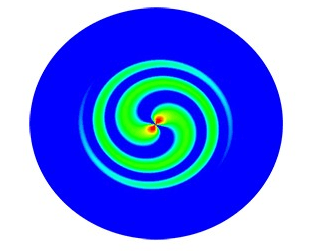Sep 9 2016
Analyzing ultrafast chemical processes requires ultrafast lasers — light pulses lasting for mere attoseconds (10-18 second) — to act as a “stop-motion” strobe camera. Physicists at the University of Nebraska-Lincoln are analyzing how ultrafast laser pulses interact with matter. Their study of how two attosecond laser pulses would interact with a helium atom produced an electron momentum distribution that displays an unexpected two-armed vortex pattern, resembling a spiral galaxy.
 A new stopwatch? Electron momentum distribution resulting from interference of the two photoelectron wave packets is produced by ionizing a helium atom using a pair of time-delayed, oppositely circularly polarized attosecond laser pulses. Scientists could use this pattern as a �stopwatch� to determine the duration of ultrafast processes. Credit: Image courtesy of Anthony Starace and Jean Marcel Ngoko Djiokap.
A new stopwatch? Electron momentum distribution resulting from interference of the two photoelectron wave packets is produced by ionizing a helium atom using a pair of time-delayed, oppositely circularly polarized attosecond laser pulses. Scientists could use this pattern as a �stopwatch� to determine the duration of ultrafast processes. Credit: Image courtesy of Anthony Starace and Jean Marcel Ngoko Djiokap.
The Impact
Attosecond-duration laser pulses provide a new tool with the potential to provide key insights on ultrafast chemical processes and ultimately to control processes that underlie energy-relevant technologies, such as solar energy conversion and catalysis. But before this new tool can meet its full potential, the pulses themselves and their fundamental interactions with matter must be understood. In this case, the researchers reveal vortex patterns produced by attosecond laser pulses can serve as an excellent diagnostic tool for characterizing the electron-manipulating laser pulses. For example, the pattern can be used to determine the intensity of the pulses and the time delay between them.
Summary
When interrogating matter with a laser pulse, the duration of the pulse plays a major role in determining the information that can be acquired. In general, the process that is being studied must occur on the same time scale as the laser pulse. For this reason, chemical dynamics processes, which often occur on the femtosecond-to-attosecond time scale, are difficult to study. Recent technological developments are beginning to make attosecond laser pulses a reality, but a great deal of mystery still surrounds the processes that these laser pulses could unveil. Scientists will often use computer simulations, based on quantum mechanical principles, to predict the ultrafast laser interactions they seek to replicate experimentally. Physicists at the University of Nebraska-Lincoln have taken this approach and simulated the interaction of a helium atom with two time-delayed attosecond laser pulses of opposite circular polarization. The resulting electron momentum distribution displays an unexpected two-armed vortex pattern. The team’s first pulse of circularly polarized light rotated in one direction, with the second rotating the opposite way. These orientations dictate whether the resulting spiral pattern appears to swirl left or right. The time delay between the pulses determines the number of windings of the two spiral arms, whereas the duration of the pulses corresponds to the width of the arms. This pattern is significant because it has been observed previously in the interaction of laser beams, but never with electrons. The similarity of the vortex pattern highlights the wave-particle duality of the electron, which describes how it behaves both as a particle and as a wave. Additionally, the discovery of the vortex pattern has many potential practical applications. Due to the extreme sensitivity of the vortex pattern to the time delay between the two pulses, analyzing the pattern could help characterize the time delay and intensity of attosecond laser pulses. Similarly, the vortex pattern could be used as a “stopwatch” to determine the duration of ultrafast processes. Also, the ability to produce a specific momentum pattern with this interaction demonstrates a new way to control electron motion with laser pulses.
Funding
Research by A.F.S. and J.M.N.D. is primarily supported by the U.S. Department of Energy (DOE), Office of Science, Basic Energy Sciences (BES), Division of Chemical Sciences, Geosciences, and Biosciences under Award No. DE-FG03-96ER14646. Research by S.X.H. is supported by the DOE National Nuclear Security Administration under Award No. DE-NA0001944, the University of Rochester, and the New York State Energy Research and Development Authority. Research by L.B.M. is supported by a European Research Council Starting Grant (ERC-StG) (Project No. 277767—TDMET) and the Villum Kann Rasmussen (VKR) Centre of Excellence, Quantum Scale Optical Processes (QUSCOPE). Research by N.L.M. and A.V.M. is supported by Russian Foundation for Basic Research Grant No. 13-02-00420 and by Ministry of Education and Science of the Russian Federation Project 1019. Computations were carried out using the Sandhills, Tusker, and Crane computing facilities of the Holland Computing Center at the University of Nebraska-Lincoln, as well as the Stampede supercomputer at the Texas Advanced Computing Center under National Science Foundation Grant No. TGPHY-120003.